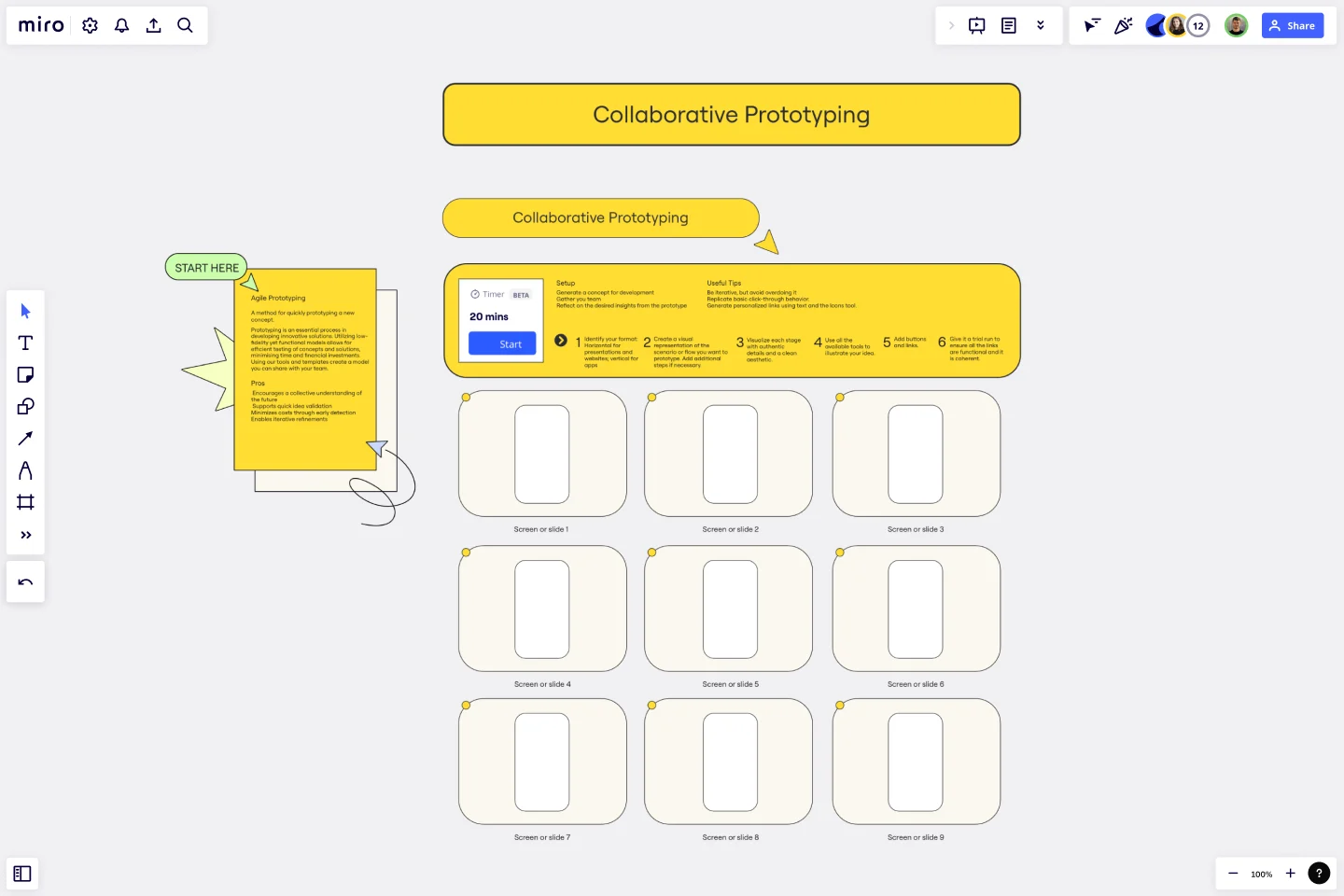Collaborative Prototyping Template
Quickly prototype a new concept with the Collaborative Prototyping Template.
About the Collaborative Prototyping Template
Rapid prototyping is an essential process in the development of innovative solutions. It involves creating low-fidelity yet functional models that efficiently test concepts and solutions. This process helps minimize time and financial investments by identifying potential issues early in the development cycle.
The Collaborative Prototyping Template is a powerful tool that can help you quickly generate concepts and validate ideas. It provides a framework for creating prototypes to share with your team, allowing for collaborative feedback and iteration.
Benefits of using the template
Encourage a collective understanding of the future.
Support quick idea validation.
Minimize costs through early detection.
Enable iterative refinements.
How to use the template in Miro
Identify your format: Horizontal for presentations and websites; vertical for apps.
Create a visual representation of the scenario or flow you want to prototype. Add additional steps if necessary.
Visualize each stage with authentic details and a clean aesthetic.
Use all the available tools to illustrate your idea.
Add buttons and links.
Give it a trial run to ensure all the links are functional and coherent.
Setup
Generate a concept for development.
Gather your team.
Reflect on the desired insights from the prototype.
Useful tips
Be iterative, but avoid overdoing it.
Replicate basic click-through behavior.
Generate personalized links using text and the Icons tool.
Get started with this template right now.
Service Blueprint by Daily Creations
Works best for:
Research & Design
Enhance your service design with the Service Blueprint template. This tool maps out the customer journey and backstage processes, helping you visualize and improve service delivery. It's perfect for aligning teams, identifying inefficiencies, and ensuring a seamless customer experience. Use this template to create a detailed roadmap of your service processes, fostering collaboration and strategic improvements in service design.
UX Project Canvas Template
Works best for:
User Experience, UX Design, Market Research
Inspired by Alexander Osterwalder's 2005 business model canvas, the project canvas will help your team visualize the big picture of your UX and design projects, providing a convenient structure that holds all of your important data. This innovative tool enables you to transform an idea into a project plan, stimulating collaboration and communication between collaborators. Unlike alternative models, the project canvas is a simple interface. There are few startup costs, and employees can easily be brought up to speed to start using the canvas quickly.
Proto Persona Template
Works best for:
Design
Business decisions frequently rely on the personal preferences and assumptions of internal employees. However, making decisions that prioritize the needs of the individuals being served is helpful. When personas are developed effectively, they provide guidance to you and your team, ensuring that the interests of these crucial stakeholders are considered when making significant decisions.
Analytics Storyboard
Works best for:
Planning, Storyboard, Design
Visualize your data insights with the Analytics Storyboard template. This tool is perfect for data analysts and business intelligence teams, helping you present complex data in a clear and engaging narrative format. It includes sections for data sources, key findings, and visualizations, ensuring your audience can easily understand and act on your insights. Use this template to create compelling data stories that drive informed decision-making and strategic planning.
Practical Customer Journey Mapping by Alex Gilev
Works best for:
Customer Journey Map
Today, customers hold companies to high standards for product quality and user experience.
Infographic Template
Works best for:
Marketing, Desk Research, Documentation
As we bet you’ve experienced, data can get pretty dense and dry. But you need it to be compelling, memorable, and understandable. The solution? Infographics. These are tools that let you present information in a visually striking way and turn quantitative or qualitative data into stories that engage and resonate. Whoever you’ll be presenting to — customers, donors, or your own internal teams — our template will let you design an infographic that combines text and visuals to break down even the most complicated data.
